Chickens might just be the perfect survival livestock. They are inexpensive to buy and feed, take little room to raise, are easy to butcher, and provide both meat and eggs for the prepping family.
Poultry are one of the few types of survival livestock that can be kept equally well by both rural and urban homesteaders – and even by urban preppers who have nothing more than a tiny backyard or even a spacious patio.
Thanks to “right to farm” laws across the country, suburban and urban preppers in the vast majorities of cities and small towns can now keep chickens. But sometimes a host of rules do apply to the keeping. Before purchasing chickens, review all state and local laws to determine if you can only keep a maximum number of birds, if roosters are allowed, and if any “quiet breeds only” regulations also exist.
Chicken Breed Facts
While you can get meat from any chicken and eggs from any hens, specific breeds have been traditionally better at producing one or the other – while some are known as multi-purpose birds that are above average in both food-producing regards.
If you are limited on space or money, or are bound by local laws to keep only three or four chickens at a time, purchasing a multi-purpose bird will most likely enhance your chances of survival. At least in the short term. It is not unusual for municipalities to enact a “no roosters allowed” rule, even in solid right to farm states.
Do not be fooled into thinking that, if you buy a rooster from the quiet breeds list, your neighbors will not know that you actually have a fella inside your coop alongside the ladies. All, and I do mean all, roosters crow. Roosters do not only crow at the crack of dawn. They will crow throughout the day as well. Sure, roosters from quiet breeds might crow a bit more softly, but crow they will.
Top 5 Quiet Chicken Breeds
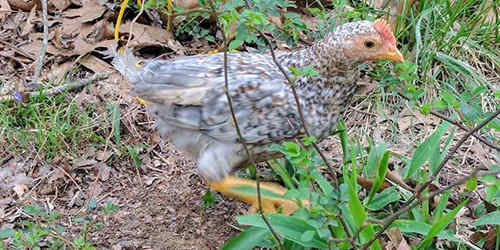
- Buff Orpington – This chicken breed is a multi-purpose bird that is also often regarded as among the easiest to handle by novice keepers. Buff Orpington roosters are typically docile birds, too.
- Ameraucana – These birds lay medium eggs and grow large enough (a full seven pounds) to be considered above-average meat birds, as well. Unless they feel threatened Ameraucana hens and roosters generally remain quiet, even when free-ranging.
- Rhode Island Reds – This chicken breed is renowned not just for its quiet and affable nature, but also because of its ability to consistently lay large brown eggs. While Rhode Island Red chickens are great layers, they are sub-par sitters. Keeping some nearly equally calm and quiet bantam hens around to sit the brown eggs is highly recommended.
- Barred Rock Plymouth – Like the Reds, Barred Rock hens also lay large brown eggs. These birds are so friendly and docile they are often treated more like farm pets than livestock. If you live in a cold climate, purchasing these hardy birds should likely be at the top of your survival livestock purchasing list due to their longevity even when subjected to chilly and harsh conditions.
- Wyandottes – This breed of chicken is not only known as a quiet breed, but is also exceptionally hardy in both cold and hot climates. Wyandottes have been known to consistently lay quality eggs year-round.
Related: How to Build an Automatic Watering Tube for Chickens
Chicken Husbandry Basics
The needs of chickens are few, but are also strict. If you fail to both learn and master basic chicken husbandry skills, the entire flock could be wiped out in a single night.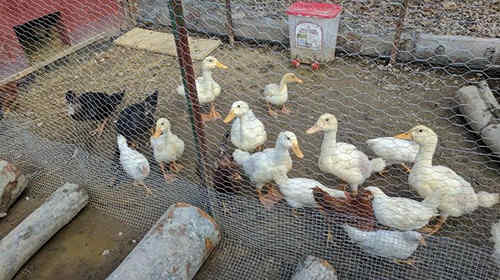
Chicken Coop And Run Tips
- Chickens are extremely vulnerable to predators, especially mink, and must be put up in a coop at night.
- Chicken wire is good for one thing only, keeping chickens in. To keep predators out, the chicken run should be constructed of hardware cloth. This is not an actual cloth at all; it is a dense wire mesh and is commonly used to construct rabbit pens. Mink, weasels, raccoons and the like cannot pry the hardware cloth apart and force themselves inside like they can do with chicken wire.
- The chicken coop should have a floor built out of pressure-treated lumber or metal sheeting – or a combination of the two, divided by hardware cloth to deter burrowing predators.
- To best protect the chickens from predators while in their run, trench the area one foot around the perimeter, place a layer of hardware cloth down, and then cover with dirt again. For an added measure of protection, cut the hardware cloth wide enough to go up the sides of the run at least one foot, to reinforce the buried hardware cloth and any chicken wire you used on the run. Again, it is best not to use chicken wire even though it is cheaper than hardware cloth, but if you have built with it already, go the extra mile to reinforce it near ground level.
- To automate your chicken habitat as much as possible, purchase a fountain style waterer that hangs or is situated on a cinder block outside of the coop to ensure a supply of clean water is always readily available.
- Use a plastic tub with a firmly fitting lid as a feeder to avoid the need to give small amounts of feed to the flock daily. Simply drill holes about three inches from the ground along the sides of the tub so the chickens can place their heads inside and enjoy dry feed as they choose for days at a time.
- Hens must each have their own nesting box that includes clean and dry straw, that is changed regularly, for bedding.
- Hens love to take “dirt baths.” Place some dirt inside of a tire or Rubbermaid bin large enough for at least one hen to climb inside so she can “bathe” in the dirt and help reduce mites and other parasites from attaching to her in the process.
- Raccoons are smart and clever creatures. Use only two-step locks on your coop and run doors. Coons have been known to unhook simple latches in under a minute and walk inside to kill chicks and steal eggs.
Related: How to Keep Eggs Fresh for a Year with Isinglass
Meat Chickens
Meat chicken are known as broilers. These birds can reach butcher weight of five pounds in as little as five weeks.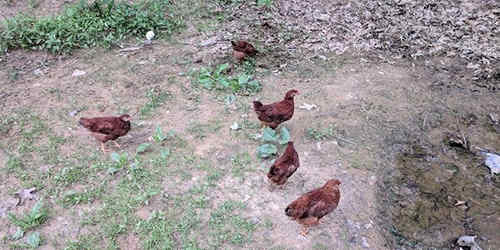
Top 5 Meat Birds
#1. Jersey Giants – This type of chicken typically grows to hit the 12-pound mark, on average.
#2. Buff Orpington – Roosters of this breed typically weigh around eight pounds on average, with hens weighing slightly less by the time they reach maturity.
#3. Cornish Cross – A typical meat chicken of this breed generally weighs between 10 to 12 pounds by the time they reach eight weeks old.
#4. Freedom Rangers – These hardy free range birds are incredible foragers and are capable of providing the bulk of their feed on their own during warm weather months. Rangers do not grow as quickly as the other meat birds on this list, but are highly regarded for rotisserie cooking.
#5. Buckeye Chickens – This heritage chicken breed is a multi-purpose bird that is quiet, docile, produces a moist meat, and is a consistent layer of brown eggs.
Egg Layers
 Most chicken breeds slow their egg-laying, or stop laying entirely, during the winter months. To encourage your hens to continue their egg production when the thermometer dips, place a solar-powered coop light (the charger sticks to the outside of the coop) or two in their living quarters to provide them with the ten hours of daylight they require to produce eggs.
Most chicken breeds slow their egg-laying, or stop laying entirely, during the winter months. To encourage your hens to continue their egg production when the thermometer dips, place a solar-powered coop light (the charger sticks to the outside of the coop) or two in their living quarters to provide them with the ten hours of daylight they require to produce eggs.
Tossing a pinch or two of cinnamon, oregano, and thyme into the chicken waterer on a daily basis, or sprinkling the herbs onto their feed, can help the hens churn out rich eggs that have a sturdy shell – even during the winter and spring, when more fragile eggs are often laid.
Top 5 Egg Laying Breeds
#1. White Leghorns – This breed can become aggressive if you do not handle them and work with them as chicks. On the other hand, white Leghorns are known to lay about 280 hardy and large white eggs annually. If you keep a Leghorn rooster, it will most likely become the leader and protector of the flock.
#2. Rhode Island Reds – These quiet beauties lay around 260 solid brown eggs per year, on average.
#3. Sussex – These birds are not only excellent layers, they are also often regarded as above-average meat chickens too. A Sussex hen should be expected to lay approximately 250 creamy light brown eggs annually.
#4. Golden Comets – This breed of chicken is exceptionally hardy in cold climates, is a heritage breed, and frequently lay up to 300 eggs on an annual basis.
#5. Barred Rocks – A hen of this type should lay about 200 eggs each year. As noted earlier in this article, Barred Rock chickens are also both docile and quiet keepers.
Best Ways To Preserve Chicken Eggs
Cold Storage
The best way to make your chicken eggs last longer is to store them in a cool place, but not necessarily your refrigerator. Eggs should be able to keep for about three months if left in their natural state with the bloom still attached, in temperatures not hotter than 55 degrees.
The bloom is the unwashed state of the egg that prevent air and bacteria from getting inside. The cold area where the eggs are kept should have a consistent humidity of about 75 percent. If the humidity gets too high, the eggs will mold. If the humidity drops too low, the eggs will dry out.
Oil Dipping
Dipping farm fresh eggs in mineral oil may allow you to safely store them for eight months to a year. To preserve eggs in this manner, remove the bloom from the eggs and work at room temperature.
- Heat the oil to about 180 degrees and hold it there for about 20 minutes to kill any bacteria present in the oil.
- Dip each egg into the hot oil using metal tongs or a slotted spoon.
- Remove the egg after dipping, and place it on a metal drying rack to drain away the excess oil. It takes about half an hour for the excess oil to drain away.
- Place the eggs in a carton or similar container and store them in the refrigerator – after marking the date they were dipped on the carton.
Related: How to Keeps Eggs Fresh for Months with Mineral Oil
Dehydrating Eggs
This manner of preservation should keep the eggs safe to eat for many years, as long as they are stored in an airtight container. I recommend using small mason jar or similar containers to avoid opening the container repeatedly and exposing the contents to the air.
- Crack the eggs into a bowl and beat them thoroughly – using a food processor or blender make absolutely certain the eggs are beaten as much as humanly possible.
- Place a plastic liner in the tray of the dehydrator. If you do not have solid liners or mesh liners for your dehydrator, they are definitely worth the nominal investment of stockpiling one for each tray.
- Pour the beaten eggs into the trays and set the temperature gauge on the vegetable setting or about 130 degrees. You should be able to fit about six to ten eggs into each tray.
- Dehydrate the eggs until they are dry, brittle, and resemble peanut brittle. This process takes about six hours in a standard home machine.
- You can store the dehydrate egg as chips of various dimensions, or run them through a food processor and turn them into a more compact powder.
- Store the eggs in a mason jar or similar airtight container.
- To reconstitute the eggs and use them for baking, cooking, or scrambling, mix them with warm (or even cold) water at a ratio of 1 teaspoon of water per every 3 tablespoons of eggs.
Top 5 Ways To Preserve Chicken
Every part of the chicken can be preserved, except the head and feet, and used in recipes. There may be some intriguing uses for chicken feet, brains, and beaks, but none that are commonplace in homesteading recipes.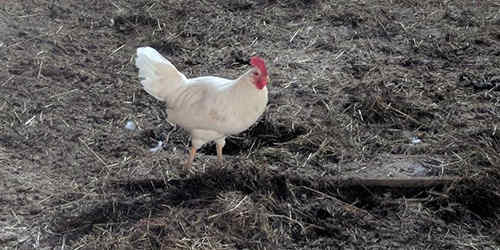
Pressure Canning
Every meat portion of the bird, pressure canned and stored in an airtight container, should keep for at least 12 months. Although the USDA might not recommend it, I have not only known preppers and homesteaders who serve pressure canned chicken parts that are two to five years old, but I have eaten the dishes and found them not only safe to consume, but just as delicious as fresh chicken.
Dehydrating
You can dehydrate chicken that has been chunked, sliced, or shredded by placing it on a mesh liner inside of a tray. Choose the meat setting on your dehydrator – it will be the hottest setting the machine can handle – and process until the meat is dry and crunchy. Some dehydrators have a jerky setting that is designed to be used after the chicken has been seasoned and run through a jerky gun. It will usually take about eight hours to dehydrate chicken, and up to 12 hours to make jerky.
Smoking
Chicken should be smoked at 145 degrees for about seven hours for best results. To hasten the time, chicken can be smoked at 155 degrees for only four hours, but the whole bird (or the portion you cut to smoke) may become dry. After smoking, put the chicken in an airtight container and store in a cool, dry place until you’re ready to use it. If smoked and stored properly, the chicken should keep for a minimum of 12 months.
Salting
When using salt to preserve chicken or any meat, never use common table salt. Only butcher or packing salt is recommended.
- To salt, put the whole chicken or chicken parts into a plastic storage tub that has an airtight lid.
- Cover all sides of the chickens with thick layers of salt. Any area left exposed to air can (and likely will) develop bacteria and spoil the meat.
- Put the lid on the container and store in a space that does not reach temperatures higher than 40 to 45 degrees, and never dips below 35 degrees, while it cures. To estimate curing time, the common rule of thumb is one week per inch of thickness.
- After the curing process is complete, the salted chicken should keep for a minimum of four months.
Bone Preservation
Boil the bones to remove all of the meat. Next you can use them to make broth, chicken soup, noodles, or a host of other homesteading favorites.
Keeping chickens will help make your survival homesteading retreat be far more sustainable. If you cannot keep a rooster due to local laws, consider butchering and preserving your birds as soon as they mature and then replenishing your flock numbers to repeat the process and stockpile more shelf stable food.
You may also like:
 How To Smoke Bacon The Old-Fashioned Way
How To Smoke Bacon The Old-Fashioned Way
World’s Smallest Battery Powers House For 2 Days (Video)
Pressure-Canning Hamburger Meat for Long Term Preservation
10 Long Shelf-Life Canned Foods Every Prepper Should Consider Stockpiling

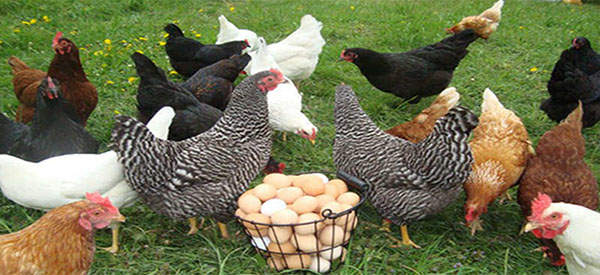













Cornish Cross meat broilers will not get to 10-12lbs in 8 weeks. More like 7lb average, and that is giving them all the commercial food they can eat.
Ours consistently reach 8-9 lbs. 7lbs are the small ones. You do have to watch them however when they get that large they can break their little legs due to the increased weight.
Hens need 16 hours of light to continue laying eggs throughout the winter.
I don’t think so Tim.
“Hens must each have their own nesting box …”
Are you kidding me?? Seriously. I’ve been raising chickens for many years now and of the 4 nesting boxes in my large coop, only 2 actually get used by the 7 hens I currently have. They will pick a place they want to lay and will continually do so in that spot. It wasn’t uncommon for me to find several (3-5) chickens in the same nest at the same time when I had 26 hens a few years ago. And while 26 hens fit well in the coop, 26 nesting boxes would never have fit at all.
I have 32 hens can you imagine 32 nest boxes I do 1 box for every 4 birds
AskAPrepper wrote, “There may be some intriguing uses for chicken feet, brains, and beaks, but none that are commonplace in homesteading recipes.”
The last item in the article mentioned making bone broth from the bones. Adding chicken feet and beaks to the bone broth will add collagen to the broth, thereby enhancing its health-giving value. Chicken feet should not be wasted; they offer valuable nutrition.
That’s right, Mtn Prepper, they make for a lip-smacking broth. My grandmothers both used the cleaned chicken feet [and duck and turkey feet, too] in stocks. You can buy them in bags in some markets around the country, too. Can’t beat home grown, though!
That’s right, Mtn Prepper. Both of my grandmothers used the cleaned chicken feet [duck and turkey feet, too] in their lip-smacking broths. You can also buy chicken feet in bags at some markets around the country.
In addition to collagen, any cartilaginous tissue adds hyaluronic acid, which is terrific for joints and skin. And expensive to buy in capsule form! Nothing beats home grown!
While stationed in Taiwan in 1970, chicken feet that were smoked with peppermint were a late-evening/wee hours snack in the bars. Something to gnaw on that was tasty but not filling, as no one ever swallowed one.
At formal dinners, the honored guest would find the chicken’s head in his soup bowl. I never saw anyone eat it. The recipient would always claim that he was not worthy of the honor and put it in the bowl of the person next to him. That person, in turn, would also claim not to be worthy, and put it in the next person’s bowl. The process was repeated until the bowls were taken away, replaced by the next course.. Sometimes the head would make it around the table twice before the next course.
One question and one comment:
In a real “prepping” situation where there are no stores to buy feed, what do you feed chickens?
Poultry netting from Premier Fencing along with a solar powered charger is an excellent way to keep chickens in and predators out.
GROW moringa olifera in aquaponics systems,,,, moringa can prevent & cure over 300 illnesses,,,, also can be eaten for food for humans and animals,,,,
if their are wild turkeys in your area the chickens will feed themselves
Can you amplify that comment a bit? How does having wild turkeys in the area allow the chickens to feed themselves?
What? Please explain
Sure is a long article. Get some chickens and you will learn in time.
Will it hurt chickens to eat boiled turkey necks, or do I need to remove the meat from the bones first?
They will pick the meat off the bone. No need to remove it for them. Mine love pork chop bones!
I live in Alaska where it stays dark up to 18-1/2 hours a day during winter. Our Experimental Farm coop teaches us to give our hens at least 14 hours of artificial light per day. I have personally experienced hens that lay all year round with no break for winter. Just sharing…
hi to all, iv heard that you can feed oats, to chickens sprout oats seeds in a 5 galon bucket, and feed to chickens wenne the oats are 2 to 3 inch. Sori for my gramar